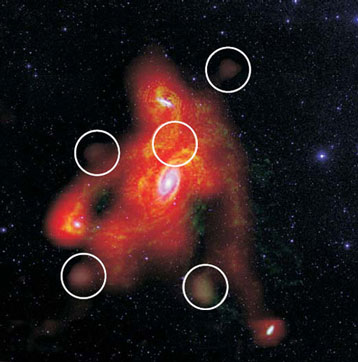NRAO eNews
October 2008 • Vol. 1, Iss. 5
- The Expansion of Supernova Remnant G21.5–0.9: Is PSR J1833–1034 the Youngest Pulsar?
- Discovery of a Small Group Driving the Evolution of an Edge-On Spiral Galaxy
- Cosmic Rays and the Magnetic Field in the Nearby Starburst Galaxy NGC 253
- Neutral Hydrogen Clouds in the M81/M82 Group
- ALMA Project Progress
- North American ALMA Science Center
- The ALMA Spectral Line Catalog
- The Birth and Feedback of Massive Stars, Within and Beyond the Galaxy: The NAASC Science Workshop for 2008
- Current Status
- VLA Configuration Schedule, Proposals, and Scheduling
- VLBA and HSA Proposals and Scheduling
- Global cm VLBI Proposals
- VLA and EVLA Spectral Line Observations Below 1200 MHz
- Status of Observing with the Transition Array
- VLBA Sensitivity Upgrade Project
- First 3mm Science Observations with the GBT and MUSTANG Call for Proposals
- The GBT Dynamic Scheduling System Update
- Progress on the Ka-Band Focal Plane Array for the GBT
- Opportunities for University-Led Technical Development Projects in Green Bank
- New NRAO Website Debuts
- The NRAO at the American Astronomical Society and American Association for the Advancement of Science Meetings
- Call for GBT Shared-Risk MUSTANG Proposals
- Large Proposals to Use NRAO Telescopes
- Chris Carilli Appointed Observatory Chief Scientist
- Eleventh Synthesis Imaging Workshop
- 2008 Grote Reber Medal Awarded to Sandy Weinreb
- NRAO Participates in the BEYA Conference
- NRAO Business Managers Meet in Chile
- NRAO Library News
- Past Issues
- Contact the Editor
- Subscribe
- More Information
NRAO Newsletter • April 2008 • Issue 115
Neutral Hydrogen Clouds in the M81/M82 GroupHigh Velocity Clouds (HVCs) of neutral hydrogen are common in the sky around the Milky Way and may result from a variety of phenomena, including primordial infall, a galactic fountain, and interaction with satellites. These processes are fundamental to the origin and evolution of the Milky Way and other galaxies, so HVCs have received increasing scrutiny in recent years. The physical qualities of the clouds, such as their mass and density, require knowledge of their distance. For Milky Way HVCs, this is particularly difficult to measure. To circumvent this problem, and to place Galactic HVCs in a larger astrophysical context, it is useful to search for HVC analogs in other galaxies whose distances are known. Previous studies have found HI structures around many galaxies, including M31 (Thilker et al. 2004) which may be related to the HVC phenomenon. We used the Green Bank Telescope to observe HI over a 3°×3° area centered on the M81/M82 galaxy group, a gas-rich system of more than a dozen galaxies with clear signs of tidal interaction. The GBT’s sensitivity to extended, low surface-brightness emission gave our maps a 7σ detection limit of 9.6×105M⊙ per beam in a single spectral channel, the lowest surface-brightness threshold of any extragalactic HVC survey to date. Spectral maps in the velocity range of interest were inspected for objects that were spatially distinct from group galaxies and tidal streams, and well-confined kinematically. We detected five previously unknown HI clouds associated with the group. 
Figure 1. Composite radio and optical image of the M81/M82 galaxy group. Orange: GBT HI column density map from Chynoweth et al (2008). New HI cloud detections are circled and highlighted in white. Yellow: VLA HI column density from Yun et al (1994). Both column density maps are integrated from -250 to 340 km s-1. Blue: Optical image from DSS. (Image credit: Chynoweth, Langston, Saxton, NRAO). The observations are shown in Figure 1, with the new clouds highlighted. Interestingly, all new HI clouds are located at small angular separation from group members, and at small velocity differences from group members. We find clouds only within 35 kpc and 120 km s-1 of associated galaxies. The new HI clouds have masses ranging from 0.69 to 8.37 ×107M⊙, similar to clouds detected around the Milky Way (Wakker & van Woerden 1997) and larger than the clouds detected in M31 (Thilker et al. 2004). These results are described in detail in Chynoweth et al. (2008). Based upon the proximity of the clouds to group galaxies in position and velocity, we conclude that the clouds are most likely relics of ongoing interactions between galaxies in the group. Our results are inconsistent with models of primordial HI cloud infall. We plan to extend our work to other nearby groups. We are currently performing detailed numerical simulations of the mass distribution and trajectories of the galaxies and newly detected clouds in the M81 group. These simulations improve upon the previous work of Yun (1999) by utilizing a fully self-consistent N-body model of the galaxy group, with particular emphasis on reproducing the isolated HI structures observed. The ultimate goal of this work is to understand the origin and evolution of extragalactic HI clouds, and their relationship to the HVCs in the Milky Way. K. M. Chynoweth, K. Holley-Bockelmann (Vanderbilt University), G. I. Langston and F. J. Lockman (NRAO) References:Chynoweth, K, M., Langston, G. I., Yun, M. S., Lockman, F. J., Rubin, K. H. R., Scoles, S. A., 2008, AJ, (in press). Thilker et al. 2004, ApJL, 601, L39 Wakker & van Woerden 1997, ARAA, 35, 217 Yun 1999, in Galaxy Interactions at Low and High Redshift, vol 186 of IAU Symposium, 81 Yun, M. S., Ho, P. T. P., Lo, K., Y. 1994, Nature, 372, 530 |
